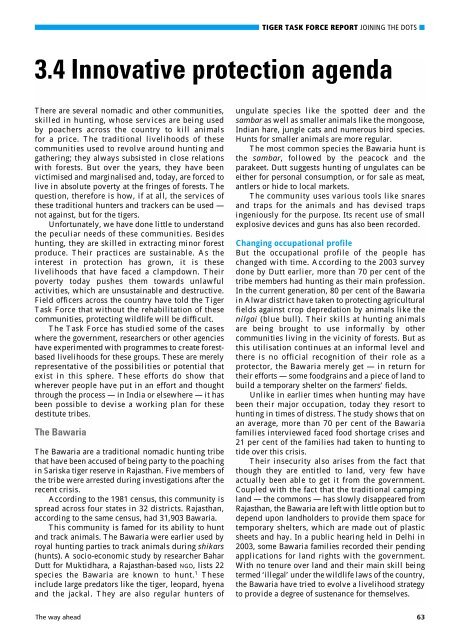Report of the Tiger Task Force - PRS
Report of the Tiger Task Force - PRS
Report of the Tiger Task Force - PRS
You also want an ePaper? Increase the reach of your titles
YUMPU automatically turns print PDFs into web optimized ePapers that Google loves.
TIGER TASK FORCE REPORT JOINING THE DOTS ■3.4 Innovative protection agendaThere are several nomadic and o<strong>the</strong>r communities,skilled in hunting, whose services are being usedby poachers across <strong>the</strong> country to kill animalsfor a price. The traditional livelihoods <strong>of</strong> <strong>the</strong>secommunities used to revolve around hunting andga<strong>the</strong>ring; <strong>the</strong>y always subsisted in close relationswith forests. But over <strong>the</strong> years, <strong>the</strong>y have beenvictimised and marginalised and, today, are forced tolive in absolute poverty at <strong>the</strong> fringes <strong>of</strong> forests. Thequestion, <strong>the</strong>refore is how, if at all, <strong>the</strong> services <strong>of</strong><strong>the</strong>se traditional hunters and trackers can be used —not against, but for <strong>the</strong> tigers.Unfortunately, we have done little to understand<strong>the</strong> peculiar needs <strong>of</strong> <strong>the</strong>se communities. Besideshunting, <strong>the</strong>y are skilled in extracting minor forestproduce. Their practices are sustainable. As <strong>the</strong>interest in protection has grown, it is <strong>the</strong>selivelihoods that have faced a clampdown. Theirpoverty today pushes <strong>the</strong>m towards unlawfulactivities, which are unsustainable and destructive.Field <strong>of</strong>ficers across <strong>the</strong> country have told <strong>the</strong> <strong>Tiger</strong><strong>Task</strong> <strong>Force</strong> that without <strong>the</strong> rehabilitation <strong>of</strong> <strong>the</strong>secommunities, protecting wildlife will be difficult.The <strong>Task</strong> <strong>Force</strong> has studied some <strong>of</strong> <strong>the</strong> caseswhere <strong>the</strong> government, researchers or o<strong>the</strong>r agencieshave experimented with programmes to create forestbasedlivelihoods for <strong>the</strong>se groups. These are merelyrepresentative <strong>of</strong> <strong>the</strong> possibilities or potential thatexist in this sphere. These efforts do show thatwherever people have put in an effort and thoughtthrough <strong>the</strong> process — in India or elsewhere — it hasbeen possible to devise a working plan for <strong>the</strong>sedestitute tribes.The BawariaThe Bawaria are a traditional nomadic hunting tribethat have been accused <strong>of</strong> being party to <strong>the</strong> poachingin Sariska tiger reserve in Rajasthan. Five members <strong>of</strong><strong>the</strong> tribe were arrested during investigations after <strong>the</strong>recent crisis.According to <strong>the</strong> 1981 census, this community isspread across four states in 32 districts. Rajasthan,according to <strong>the</strong> same census, had 31,903 Bawaria.This community is famed for its ability to huntand track animals. The Bawaria were earlier used byroyal hunting parties to track animals during shikars(hunts). A socio-economic study by researcher BaharDutt for Muktidhara, a Rajasthan-based NGO, lists 22species <strong>the</strong> Bawaria are known to hunt. 1 Theseinclude large predators like <strong>the</strong> tiger, leopard, hyenaand <strong>the</strong> jackal. They are also regular hunters <strong>of</strong>ungulate species like <strong>the</strong> spotted deer and <strong>the</strong>sambar as well as smaller animals like <strong>the</strong> mongoose,Indian hare, jungle cats and numerous bird species.Hunts for smaller animals are more regular.The most common species <strong>the</strong> Bawaria hunt is<strong>the</strong> sambar, followed by <strong>the</strong> peacock and <strong>the</strong>parakeet. Dutt suggests hunting <strong>of</strong> ungulates can beei<strong>the</strong>r for personal consumption, or for sale as meat,antlers or hide to local markets.The community uses various tools like snaresand traps for <strong>the</strong> animals and has devised trapsingeniously for <strong>the</strong> purpose. Its recent use <strong>of</strong> smallexplosive devices and guns has also been recorded.Changing occupational pr<strong>of</strong>ileBut <strong>the</strong> occupational pr<strong>of</strong>ile <strong>of</strong> <strong>the</strong> people haschanged with time. According to <strong>the</strong> 2003 surveydone by Dutt earlier, more than 70 per cent <strong>of</strong> <strong>the</strong>tribe members had hunting as <strong>the</strong>ir main pr<strong>of</strong>ession.In <strong>the</strong> current generation, 80 per cent <strong>of</strong> <strong>the</strong> Bawariain Alwar district have taken to protecting agriculturalfields against crop depredation by animals like <strong>the</strong>nilgai (blue bull). Their skills at hunting animalsare being brought to use informally by o<strong>the</strong>rcommunities living in <strong>the</strong> vicinity <strong>of</strong> forests. But asthis utilisation continues at an informal level and<strong>the</strong>re is no <strong>of</strong>ficial recognition <strong>of</strong> <strong>the</strong>ir role as aprotector, <strong>the</strong> Bawaria merely get — in return for<strong>the</strong>ir efforts — some foodgrains and a piece <strong>of</strong> land tobuild a temporary shelter on <strong>the</strong> farmers’ fields.Unlike in earlier times when hunting may havebeen <strong>the</strong>ir major occupation, today <strong>the</strong>y resort tohunting in times <strong>of</strong> distress. The study shows that onan average, more than 70 per cent <strong>of</strong> <strong>the</strong> Bawariafamilies interviewed faced food shortage crises and21 per cent <strong>of</strong> <strong>the</strong> families had taken to hunting totide over this crisis.Their insecurity also arises from <strong>the</strong> fact thatthough <strong>the</strong>y are entitled to land, very few haveactually been able to get it from <strong>the</strong> government.Coupled with <strong>the</strong> fact that <strong>the</strong> traditional campingland — <strong>the</strong> commons — has slowly disappeared fromRajasthan, <strong>the</strong> Bawaria are left with little option but todepend upon landholders to provide <strong>the</strong>m space fortemporary shelters, which are made out <strong>of</strong> plasticsheets and hay. In a public hearing held in Delhi in2003, some Bawaria families recorded <strong>the</strong>ir pendingapplications for land rights with <strong>the</strong> government.With no tenure over land and <strong>the</strong>ir main skill beingtermed ‘illegal’ under <strong>the</strong> wildlife laws <strong>of</strong> <strong>the</strong> country,<strong>the</strong> Bawaria have tried to evolve a livelihood strategyto provide a degree <strong>of</strong> sustenance for <strong>the</strong>mselves.The way ahead 63
















